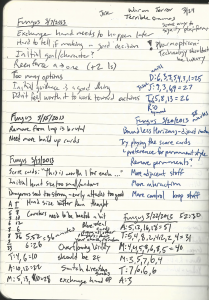Last time on Board Game Design Basics, I gave a theoretical justification of playtesting and discussed some of the types of playtests you’ll be running over the course of developing your game. Today I’ll pick up where I left off, getting to more practical matters like who should playtest and how to make use of data and feedback. Let’s dive right in!
The Who’s Who of Playtesting!
So you’re ready to start playtesting.
…who should do the playtesting?
The short answer is everyone you can get to playtest! But the slightly longer answer is different people at different times during the development of a game. (For a review of the stages of development, check out my last post on playtesting.)

The first blind playtest of Corporate America with some friends. Image from the Presidential Hats Tumblr.
Friends are great for the Early Exploration phase, assuming they can see beyond the many rough edges of an early prototype. While flattery can be great medicine for the ego, honesty is more important. It’s also a good idea to not expose all of your friends to your awesome new creation right away, since you need to test the game on first timers throughout the development process. Keep a list of people that want to play the game but haven’t yet so you can find fresh playtesters when you need them.
Hard core gamer friends are very good early in development, when they can identify structural problems and offer suggestions, but are even more important when you’re working on balance. You will need some people to scour the depths of what your game offers, and a group or two of gamer friends are the best people to do it.
Finding strangers to play your game can be difficult, but it’s vital, especially as the structural changes are getting ironed out and you’re ready to start testing accessibility and rules. You will definitely need to host several blind playtests with strangers who learn to play the game by reading the rules without your intervention. You can find strangers at local game shops, game conventions, at parks or college campuses, or even through craigslist. Remember, strangers are just friends you haven’t met yet! *wink*
You should playtest with everyone who’s willing, but you should consider your target audience, as well. It can be counter productive to playtest with people outside of the scope of your target audience, since they could easily have a negative experience, which might make you think you’re on the wrong track (even though people you want to enjoy the game might love it).
We’ve covered friends and strangers, but what about you? Obviously, you want to play your own game! During most stages of development you can totally get away with it… just remember that your data is less useful when you’re playing. You should also make sure you run several playtests without participating, especially in the Accessibility and Rules stage of development. You can definitely help balance, as well, but when it comes to highly strategic games, beware of knowing your game too well–if you know the game much better than your opponents, your data will be too skewed to be useful.
The Joy of Data!
You should always carry a notebook around with you (who knows when inspiration will strike!), but it’s especially important to have one when you playtest. You will want to jot down notes so you can reference them later. In addition to writing down feedback from players, you also might want to keep track of the following:
– Playtesters and date.
– Play time.
– Final scores.
– Scores throughout game (to monitor game pacing).
– The number of components used (think disease cubes in Pandemic or dollar bills in Corporate America).
– Any awkward events that occurred during the game (overpowered or ambiguous card combinations, confusion, annoyingly long turns, turns where a player did nothing, etc).
– Any particularly bad experiences players had.
You’re going into the playtest with a goal and a hypothesis, right? Figure out what information would be useful for that goal and make sure you keep track of it during the playtest. Keeping standardized notes will allow you to track how the game is progressing between playtests, which is important to make sure your changes are taking the game in the right direction.
Taking Criticism Like a Champ!
You’re asking people to playtest your game, spending their time and mental energy. You want feedback, right? Not just to stroke your ego? Ok, good.
Then be happy when they offer feedback! Honestly, no feedback is a very bad sign… that usually means the game is in such bad shape that your players don’t even know where to begin to fix it. Players dumping ideas for the game after playtesting is a great sign! It means your game has inspired them and they want more.
Taking feedback can be very challenging. You need to learn to distance yourself emotionally from your ideas. Whatever you do, do not get defensive! Even if you disagree with feedback a playtester offers, take that criticism with grace. Perhaps there is a gem of useful information in there even if the surface suggestion isn’t particularly helpful.
Always write down feedback. It’s good to be able to reference it later and it makes your playtesters feel like you’re taking them seriously (which you should be doing anyway).
Do not take feedback and suggestions from playtesters as scripture. Remember that they’ve played your game once or twice, and you’ve seen it played many times and thought about it for hours. Often times, first impressions are wrong. But don’t forget that first impressions are important in their own right, even if inaccurate. Take all feedback seriously.
Often times, you should think of playtester feedback as a little puzzle. Playtesters will offer suggestions about how to change the game, frequently suggesting new stuff to add to the game. While some of these ideas will be good, your job is to cut out unnecessary clutter from your game, so you should be resistant to those types of suggestions. Still, the suggestion is most likely indicative of some sort of problem the playtester experienced. Your job is to look past the surface suggestion to discover the reason the playtester made the suggestion. Once you’ve discovered that, you can determine whether the suggestion actually addresses the problem or if there’s another solution that might work better.
All’s Well that Ends Well?
Playtesting might be work, but it should be fun, right?
You might hope so, but just like a scientific experiment, negative results can often be more enlightening than positive results. Humans dislike bad experiences much more than they like good experiences, so it’s important to try to stamp bad experiences out of your game if at all possible. As painful as they can be to live through, playtests that go poorly give you a glimpse into areas where your game really needs help. They can also jolt you into action, forcing you to accept the writing on the wall. Playtests that aren’t fun are often the most helpful. This is another reason having honest playtesters who won’t sugar coat their experiences are the best playtesters you can hope for.
Alright, that’s all I have about playtesting for the time being. Now get out there and playtest! I hope it goes terribly for you!


5 Comments